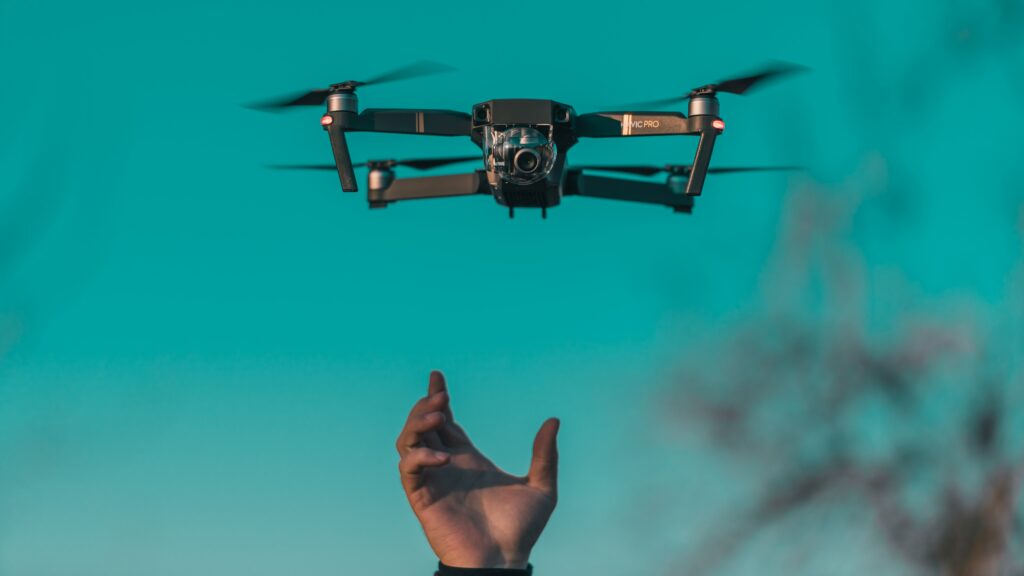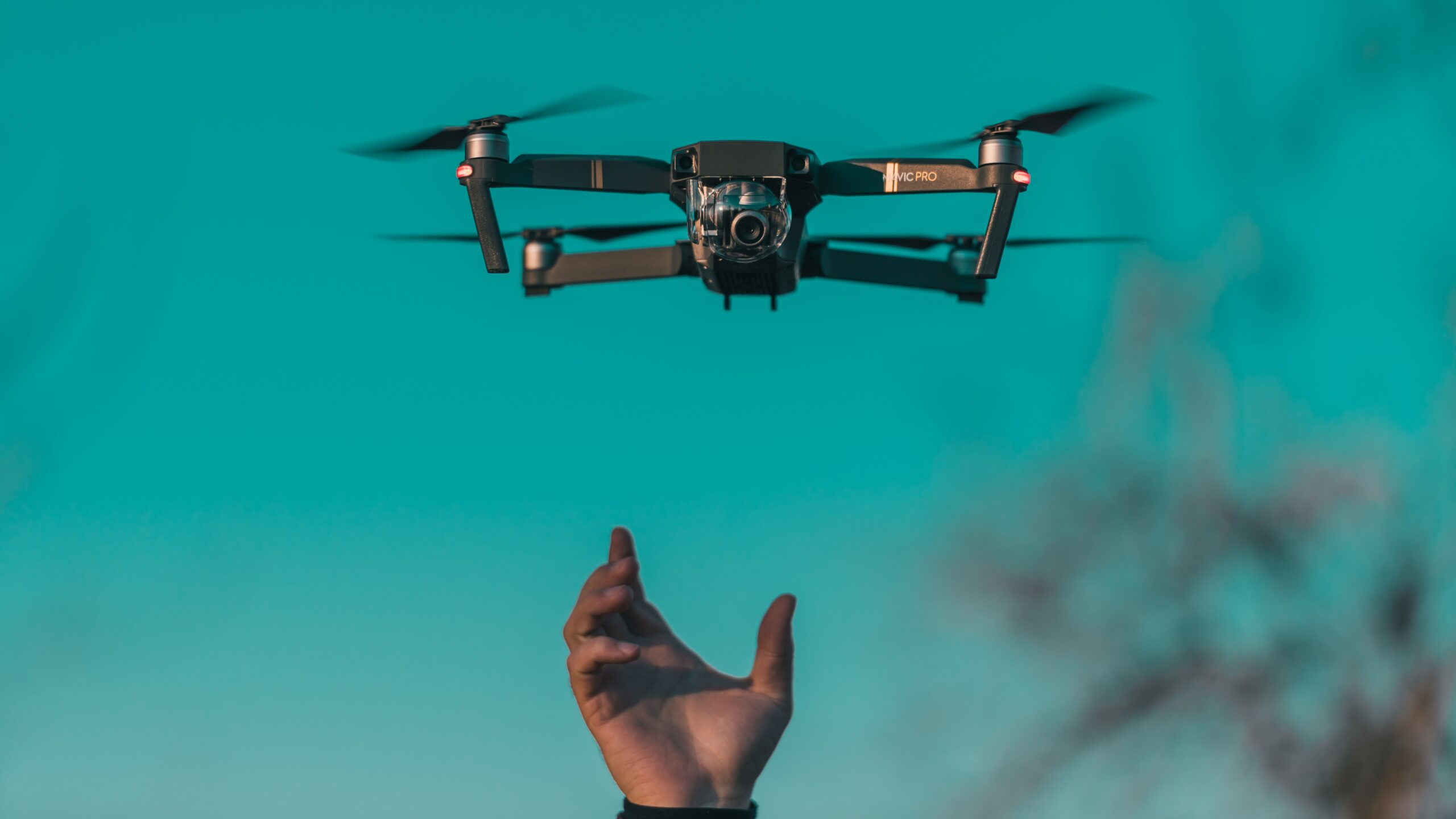This is the second in a series of blogs by Dr Anna Jackman highlighting findings from the ESRC-funded research project Diversifying Drone Stories.
Drone use in the UK is growing. Figures from the Civil Aviation Authority state that as of March 2023, there were ‘513,860 active registered drone flyers and operators’.

Alongside a growth in hobbyist use, drones are increasingly deployed as commercial tools to gather aerial imagery, video and sensor data and to transport and carry goods, across an array of sectors and applications. From agriculture and construction to oil and gas, drones have been praised as carrying out tasks ‘faster, cheaper and with less impact on the environment than traditional methods’.
In a 2022 ambition statement, the UK Government envisioned that ‘by 2030 commercial drones will be commonplace in the UK in a way that safely benefits the economy and wider society’, ‘while sharing airspace equitably and safely with other users’. Such visions echo wider market forecasting around the ‘potential for drones to positively impact the UK economy’.
Yet while such reporting highlights ambitions that ‘drones could contribute up to £45bn to the UK economy’ by 2030, so too does it describe a range of challenges to be addressed – from public perception and regulation, to technology and implementation – in order to realise these benefits.
To this end, the public’s perception of and readiness for future flight technologies, including drones, has been identified as a priority area for social science, and researchers have drawn attention to the concerns – from privacy and safety, to security, visual and noise pollution – of communities and members of the public living under drones.
As part of my ESRC-funded research project, Diversifying Drone Stories, I led focus groups with members of the UK drone industry to understand their views on the impacts of drones and how these can be responded to through best practice.
Working in collaboration with ARPAS-UK, the UK drone trade association, we produced an Industry Toolkit on professional, responsible and considerate commercial drone use, and a Report sharing industry views on the sector. These are some of my findings.
Commercial drone impacts on communities and environments
While drones offer a range of benefits, they can also prompt concerns from members of the public around privacy, safety, and noise disruption. Participating members of the drone industry encouraged consideration of these concerns, as well as engagement with local communities in areas of drone flight.
Drones can also impact wildlife. Participants suggested that considering the choice and size of drone and flight pattern can reduce potential impacts. While highlighting that drones can reduce carbon emissions, participants urged further consideration of their wider environmental impacts. They also highlighted that commercial drone use both impacts and is impacted by other airspace users, including piloted aviation.
Professional, responsible and considerate commercial drone best practice
Participating members of the drone industry stressed the importance of awareness and adherence to applicable regulations, as well as proactive flight planning and risk assessment. They urged considering and engaging with local communities and stakeholders in the flight area, detailing a range of potential approaches, such as residential advisories and dedicating ‘extra time’ to provide information and answer questions.
Participants advised additional measures where subcontracted pilots are used, as well as the careful maintenance of equipment. They also stressed the importance of being visible, both digitally (via flight planning apps) and physically (for example, operators wearing high vis). They also encouraged thinking like an aviator and heeding lessons learned from piloted aviation, particularly in the area of safety.
Challenges and barriers facing the commercial drone industry
A range of challenges and barriers were identified. During flight planning these included: landowner identification, navigating blanket bans and local byelaws, and processes for notifying local police about drone flights.
They also raised issues around UK drone regulation, including: difficulties and (cost-incurring) delays associated with approvals to fly, lengthy response times, and frustrations around Beyond Visual Line of Sight (BVLOS), namely facilitating the safe flight of drones outside of sight range, remaining in their infancy, impacting scalability.
Concerns were expressed that innovation was potentially being stifled and talent lost to other countries. Participants also raised concerns about other airspace users, both with regard to ongoing barriers around electronic conspicuity (umbrella term for technology enabling airspace users and air traffic services be more aware of what is operating in surrounding airspace) and in relation to tensions with the General Aviation community. Participants encouraged further dialogue between different airspace users.

Ambitions and desires for the future of the commercial drone industry
Participating members of the drone industry described ambitions and desires around the visibility of all aircraft to enable scaling and the development and normalisation of business as usual drone operations and routine BVLOS flight.
They described the need for more: opportunities to test and validate operations, research and development resourcing, automation of aspects of air traffic control, and support to encourage women into the sector.
They encouraged greater engagement with local communities and stakeholders as drone innovation progresses. Lastly, some participants desired a shift from one-person-to-one-drone to one-person-to-multiple-aircraft in the future, to enable the scaling of operations.
You can access the Industry Toolkit and Industry Report, and read more about the wider project findings.
Dr Anna Jackman is a Lecturer in Human Geography at the University of Reading.

